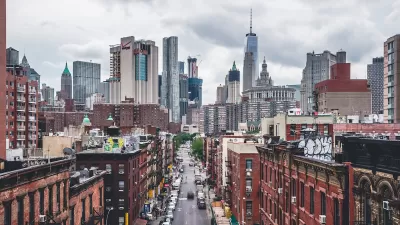Is it mid-March already? I’m far overdue for announcing my departure from Planetizen, which happened at the tail end of 2011. It was a wonderful 3 ½ years at the helm, and I thank Chris Steins and Abhijeet Chavan for giving me the opportunity back in 2008 to steer this incomparable resource.
Is it mid-March already?
I'm far overdue for
announcing my departure from Planetizen, which happened at the tail end of
2011. It was a wonderful 3 ½ years at the helm, and I thank Chris Steins and
Abhijeet Chavan for giving me the opportunity back in 2008 to steer this incomparable
resource.
One of the most interesting aspects of editing Planetizen was the birds-eye
view of urban planning and its internal debates. Planetizen's policy has always
been to encourage commentary from all sides, including those deemed unpopular
by the majority of the field. I admire this journalistic policy, and as I
depart I feel the opportunity is ripe to loosen my tongue and add a few
opinions of my own to matters of ongoing debate.
1. Urbanism is for everyone.
I'll
point the finger at Joel Kotkin for this one: he's in large part responsible
for popularizing in the media the confused idea that the suburbs are at war
with the cities. I won't go too deep, but Kotkin's definitions are flawed and out of date. It's easy to say everyone wants to live in the
suburbs when you define the suburbs as everything smaller than a skyscraper.
Beyond
the definitional confusion, the debate seems like a complete distraction from
what is happening on the ground today, which as I see it, is an acceptance of the definition of good urbanism at all
levels of density - city, small town or rural. Whatever you want to call
it, practitioners are embracing walkability, mixing uses and creating quality
places for people to come together. The decades-long rejection of the public
realm in favor of convenient parking is mostly, finally over.
2. Traditionalists need to get over themselves.
I'm going out on a limb on this one, because I have
many friends in CNU that embrace the idea that traditional architecture and
planning are the only tried-and-true way to build quality places. I understand
the sentiment – there is a lot of crappy construction out there, and there are
a handful of folks in academia who are too wound up in the esoterica of avant-garde
architecture and design. But rejecting new ideas in architecture as a whole is
throwing out the baby with the bathwater.
You can preserve the basics of good urbanism that we all agree on and
still create sexy buildings that are (heavens!) modern in style. David Baker + Partners in San Francisco, to name just one, is doing excellent contemporary,
affordable designs that people love, and that are on-target urbanistically.
3. Gentrification is the life cycle of a thriving city.
If
a city is going to be healthy economically, there will always be neighborhoods
that are revitalized and brought up from poverty, and populations will
shift. Some concerns about displacement
are appropriate, and communities need to have the levers in place to help
people stay in their communities and contribute to revitalization. But in some
cities, anti-gentrification forces actually prevent economic development and
urban vitality. Done properly, a rising tide can raise all, or at least most,
ships. It would be a true shame, as we pull ourselves out of the economic
recession of the last few years, if a small force of anti-gentrification
advocates managed to prevent much-needed economic investment in underdeveloped
urban communities, thus doing a disservice to those communities as they are
left to wither.
Barbs and strong opinions welcome (I'm waiting for you, Dano).
Please make new managing
editor Jonathan Nettler feel welcome.
I've met with him a few times since he took the reins, and I feel like
Planetizen is in very capable hands.
I'm also pleased to report
that I'm working now for an exciting new venture with the ever-inspiring Carol
Coletta called ArtPlace.
ArtPlace is a collaboration of eleven of the nation's top foundations, eight
federal agencies including the National Endowment for the Arts, and six of the
nation's largest banks. The motivating theory behind ArtPlace is that art,
culture and creativity create vibrancy and increases economic opportunity.
That's a mission I can get behind.
I'll always be an "editor
emeritus" of Planetizen, and will try to blog regularly.
After all these years, I still feel strongly that we, as urbanists, are one of
the only fields that truly have holistic solutions for saving the world. Amid
the debates and endless public meetings, we should celebrate that and always
hold true to our knowledge and our ideals.

Manufactured Crisis: Losing the Nation’s Largest Source of Unsubsidized Affordable Housing
Manufactured housing communities have long been an affordable housing option for millions of people living in the U.S., but that affordability is disappearing rapidly. How did we get here?

Americans May Be Stuck — But Why?
Americans are moving a lot less than they once did, and that is a problem. While Yoni Applebaum, in his highly-publicized article Stuck, gets the reasons badly wrong, it's still important to ask: why are we moving so much less than before?

Using Old Oil and Gas Wells for Green Energy Storage
Penn State researchers have found that repurposing abandoned oil and gas wells for geothermal-assisted compressed-air energy storage can boost efficiency, reduce environmental risks, and support clean energy and job transitions.

Updating LA’s Tree Rules Could Bring More Shade to Underserved Neighborhoods
A new USC study finds that relaxing Los Angeles’ outdated tree planting guidelines could significantly expand urban tree canopy and reduce shade disparities in lower-income neighborhoods, though infrastructure investments are also needed.

California's Canal Solar Projects Aim to Conserve Resources and Expand Clean Energy
California’s Project Nexus has begun generating electricity from solar panels installed over irrigation canals, with researchers and state agencies exploring statewide expansion to conserve water and boost clean energy production.

HHS Staff Cuts Gut Energy Assistance Program
The full staff of a federal program that distributes heating and cooling assistance for low-income families was laid off, jeopardizing the program’s operations.
Urban Design for Planners 1: Software Tools
This six-course series explores essential urban design concepts using open source software and equips planners with the tools they need to participate fully in the urban design process.
Planning for Universal Design
Learn the tools for implementing Universal Design in planning regulations.
Heyer Gruel & Associates PA
City of Moreno Valley
Institute for Housing and Urban Development Studies (IHS)
City of Grandview
Harvard GSD Executive Education
Salt Lake City
NYU Wagner Graduate School of Public Service
City of Cambridge, Maryland






























